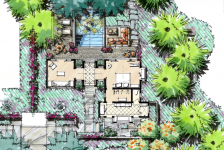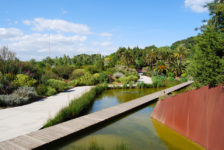For me, the LARE’s Section 1: Project & Construction Administration was one of the most daunting parts of the exam due to the fact that I don’t handle contracts on a regular basis. Consequently, Section 1 is also one of the hardest sections for new professionals to tackle because the topics deal with business and legal matters that they often have not yet experienced. An understanding of project management, however, proves incredibly beneficial and I was able to sufficiently prepare myself for the exam by supplementing my real life experience with the following study materials and tips.
The focus of Section 1 of the LARE is Project and Construction Administration with ‘Project Management’ covering 62% of the topics and ‘Bidding and Construction’ covering the remaining 38%. This is essentially a part of Section A of the old version of the test. While the topics are the same, this section, like the other three, is now completely computer-based. The entire section is also multiple choice. One benefit of the new computer-based test is the ability to flag a question so you can easily come back to it at a later time.
While the topics are the same as Section A, many test takers have noticed that there has been a shift in focus. All previous study materials are applicable, but I strongly recommend using the most up-to-date practice tests and rubrics. Many people have noticed that there is less focus on very specific topics such as the different types of liens or methods of payment. As with other sections of the LARE, Section 1 aims to make sure a licensure candidate has more of a understanding of the overall project process, different stages of design and construction, and
Before moving forward – please take a look at CLARB’s LARE Orientation Guide if you haven’t already.
SECTION 1 ONLINE RESOURCES
This is a list of general contract terms that can be on the exam. It is important to make sure that you understand client/contractor relationships, the contracting schedule of events, notifications to bid/proceed/etc, and the legal requirements to start/finish a project.
One of the best places on the Internet right now to get study materials as well as feedback on questions that you might have about the exam is the unofficial LARE EXAM Google group. Here hundreds of test takers as well as test prep professionals exchange exam tips and study materials.
L.A.R.E. – ANYTHING GOES Land8 Group
If you haven’t already joined Brandon Reed’s Land8 LARE group, what are you waiting for? This is also another fantastic resource for members to swap study materials and ask questions.
Using flash cards is one of my favorite ways to study, especially if they’ve been pre-made. Many people – including myself – have created personal study material flashcards that are ready to use. Making your own flashcards is a great way to study however, so I still encourage you to create your own set tailored to your own preferences. I would also recommend installing a flashcard app that links to a site like Cram so you have your cards on the go.
These are a must-have if you want the most accurate representation of topics covered in the new exam.
PPI: Power to Pass Exam Reviews
PPI has long provided test prep materials including practice exams and study guides. The books are written by professors and professionals in the industry and are a good overall resource to study for the new exam formats. They seem to have retrofitted their older Section A-E materials into a new package for Sections 1-4, however which may make the materials a little less accurate than before.
Kevin Worthington’s LARE Study Guides
Land8 member Cheryl Corson is well known for her LARE webinars and her great advice for taking the LARE.
Below I’ve listed CLARB’s reading suggestions for Section 1. If you are already feeling the hit to your wallet from the study guides and test fees, the last thing that you’ll want to do is spend an additional $300+ dollars for the below books. I would say that depending on your method of study, you should pick either the comprehensive study guides mentioned above or the books; it’s probably not necessary to buy both. Remember to check your company, school, or library to see if they have these books on hand or if they are willing to purchase them as additions to their library. If so, this is a great way to supplement your studying for free.
Construction Contracts, 2nd Edition / Hinze
This is probably one of the most useful books in this list as it outlines many concepts that most landscape architects do not use everyday. However, it was my conclusion that most of the very specific material covered in this book is not really mentioned on the exam. If you are confused about any of the legal aspects of contracts then this is definitely a book that you should look into. To pass section 1, you must have proficient knowledge of the process by which contracts are given and fulfilled. There is less emphasis on topics such as lien types and specific clauses for different circumstances.
Project Management for Design Professionals / Ramroth
Often required reading in college, this book outlines the different stages of project management in fine detail. Any professional will tell you that this process is often thrown out the window based on unique client demands and schedule. However, since all test takers will be working off the same rubric, this books is perfect for outlining the reasoning behind each method. Since 62% of the exam covers project management, I think that this book is an essential resource.
Ready, Set, Practice: Elements of Landscape Architecture Professional Practice / Sharky
Another mainstay of any collegiate level professional practice class, this book is a must read if you are not familiar with how a design-based business works. Topics in the book cover design process, client relations, and other topics that are tested on in the exam.
Sustainability and Design Ethics / Russ
This is a newer addition to the recommended reading list. I found that this book was not as conducive to studying, but it might be good to read through at least once to make sure you are familiar with the topics covered. CLARB is attempting to integrate sustainability into more areas of the exam (other than just design and construction) so do not be surprised when design ethics are brought up in Section 1. The books is fairly short and is rather expensive for its size. If you have a good study guide then this is a book I would omit.
RECOMMENDED STUDY METHODS FOR SECTION 1
To pass the LARE Section 1, you need to know the glossary of terms, read the textbook and take practice exams. My main method to prepare for Section 1 was to create a large collection of study flash cards.
Instead of writing notes from the text book, I would create a flashcard that asked a question based on the material that I was reading. This way, I could incorporate all of my notes into one personal flashcard test session. Using a flashcard app, I was able to test myself during any down time I had.
I also strongly recommend waiting as long as possible before taking the practice exams. They are a great resource, but if you take them cold without any studying, you won’t have a chance to assess how well you’ve prepared later on. My advice is to wait until two weeks before the exam to break into those practice tests. This will give you enough time to get acquainted with the types of questions that will be asked as well as double back on topics that you may have not comprehensively covered in your studies.
All this said, everyone studies differently, so it’s important to find a study method that is best suited for you. The LARE really tests application of the study topics as opposed to just the definition to some term. Critical thinking is a big component so your success in Section 1 hinges on how well you can explain how the design process works, both from a project management standpoint as well as from the stance of a contractor.
Good luck!
This is part of an ongoing series spotlighting the Landscape Architecture Registration Examination (LARE) administered by the Council of Landscape Architectural Registration Boards (CLARB). If you have any resources that you can add to this guide we would be happy to include you and give you credit. Please contact the author Benjamin Boyd if you have any additional resources that you’d like to share.
Check out our guide to Section 2: Site Inventory and Analysis

















CassieNichols
Has anyone had any experience using the International Edition of a textbook? I found Construction Contracts for less than $20 new, but the US Edition is $180. Any idea if it’s the same information? The book sellers claim it’s the same- but the huge price difference makes me a little nervous.
Benjamin Boyd
I haven’t had any experience with the international version of the book specifically, but I can say that international contracting is pretty different than domestic. There is probably information in that version that you don’t need and its probably missing stuff that you do. I would be wary of getting it just because of the price and try to explore other means of getting the text instead. Many people on that LARE Google group sell their study material. My company has a library copy and to be honest I only used it for reference.
Cheryl Corson
Excellent article Benjamin! Another resource I find helpful is “Law and Practice for Architects” by Greenstreet, Greenstreet, and Schermer. Similar to Hinze, in that it covers contracts, but it goes beyond contracts into the design and construction phases, which comes in handy for Section 4. Applicable to landscape architects, title aside.